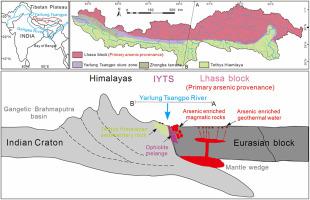当前位置:
X-MOL 学术
›
Appl. Geochem.
›
论文详情
Our official English website, www.x-mol.net, welcomes your feedback! (Note: you will need to create a separate account there.)
Enrichment of arsenic in the Yarlung Tsangpo basin, Southern Tibetan Plateau: Provenance, process, and link with tectonic setting
Applied Geochemistry ( IF 3.4 ) Pub Date : 2024-03-07 , DOI: 10.1016/j.apgeochem.2024.105964 Li Zhou , Zhifang Xu , Peikuan Fan , Jianwei Zhou
Applied Geochemistry ( IF 3.4 ) Pub Date : 2024-03-07 , DOI: 10.1016/j.apgeochem.2024.105964 Li Zhou , Zhifang Xu , Peikuan Fan , Jianwei Zhou

|
Geogenic As enrichment is prevalent in freshwater systems worldwide, yet the connection between such enrichment and regional tectonics remains poorly understood, especially within orogenic environments like the Tibetan Plateau. To provide new insights into the sources and processes of arsenic, as well as its relationship with tectonics in the plateau basin, we selected the Yarlung Tsangpo basin, situated at the collision zone between the Indian (Himalaya block) and Eurasian plates (Lhasa block) as the study area. We analyzed and compared the chemical compositions of waters and sediments across various litho-tectonic domains. This also involved assessing arsenic concentrations in river waters, suspended particulate matter (SPM), sediments, geothermal waters, and rocks. The main findings are as follows: (a) High-arsenic geothermal waters and igneous rocks are common in the Lhasa block, and the discharge of these geothermal waters is the main source of dissolved As in river water, whereas erosion of igneous rocks contributes most of the As in sediments. (b) Metal oxides adsorb dissolved As, which leads to further As enrichment in the sediments. (c) The occurrence of high As concentrations in the southern Tibetan Plateau can be explained by a crustal cycling model. Arsenic likely originated in Neo-Tethys oceanic crustal rocks and was concentrated in the upper crust of the active continental margin (Lhasa block) during geological cycling at convergent plate boundaries. These studies highlight the role of tectonic settings on influencing arsenic enrichment in the plateau basin.
中文翻译:

青藏高原南部雅鲁藏布江盆地砷富集:来源、过程及其与构造环境的联系
地质成因砷富集在世界各地的淡水系统中普遍存在,但这种富集与区域构造之间的联系仍然知之甚少,特别是在青藏高原等造山环境中。为了对砷的来源、过程及其与高原盆地构造的关系提供新的认识,我们选择了位于印度板块(喜马拉雅地块)和欧亚板块(拉萨地块)碰撞带的雅鲁藏布江盆地。作为研究区。我们分析并比较了不同岩石构造域的水体和沉积物的化学成分。这还涉及评估河水、悬浮颗粒物 (SPM)、沉积物、地热水和岩石中的砷浓度。主要发现如下: (a) 拉萨地块普遍存在高砷地热水和火成岩,这些地热水的排放是河水中溶解砷的主要来源,而火成岩的侵蚀贡献最大。沉积物中的砷。 (b) 金属氧化物吸附溶解的砷,导致沉积物中的砷进一步富集。 (c) 青藏高原南部出现的高砷浓度可以用地壳循环模型来解释。砷可能起源于新特提斯洋地壳岩石,并在地质循环期间在汇聚板块边界富集在活动大陆边缘(拉萨地块)的上地壳中。这些研究强调了构造环境对高原盆地砷富集的影响。
更新日期:2024-03-07
中文翻译:

青藏高原南部雅鲁藏布江盆地砷富集:来源、过程及其与构造环境的联系
地质成因砷富集在世界各地的淡水系统中普遍存在,但这种富集与区域构造之间的联系仍然知之甚少,特别是在青藏高原等造山环境中。为了对砷的来源、过程及其与高原盆地构造的关系提供新的认识,我们选择了位于印度板块(喜马拉雅地块)和欧亚板块(拉萨地块)碰撞带的雅鲁藏布江盆地。作为研究区。我们分析并比较了不同岩石构造域的水体和沉积物的化学成分。这还涉及评估河水、悬浮颗粒物 (SPM)、沉积物、地热水和岩石中的砷浓度。主要发现如下: (a) 拉萨地块普遍存在高砷地热水和火成岩,这些地热水的排放是河水中溶解砷的主要来源,而火成岩的侵蚀贡献最大。沉积物中的砷。 (b) 金属氧化物吸附溶解的砷,导致沉积物中的砷进一步富集。 (c) 青藏高原南部出现的高砷浓度可以用地壳循环模型来解释。砷可能起源于新特提斯洋地壳岩石,并在地质循环期间在汇聚板块边界富集在活动大陆边缘(拉萨地块)的上地壳中。这些研究强调了构造环境对高原盆地砷富集的影响。



























 京公网安备 11010802027423号
京公网安备 11010802027423号